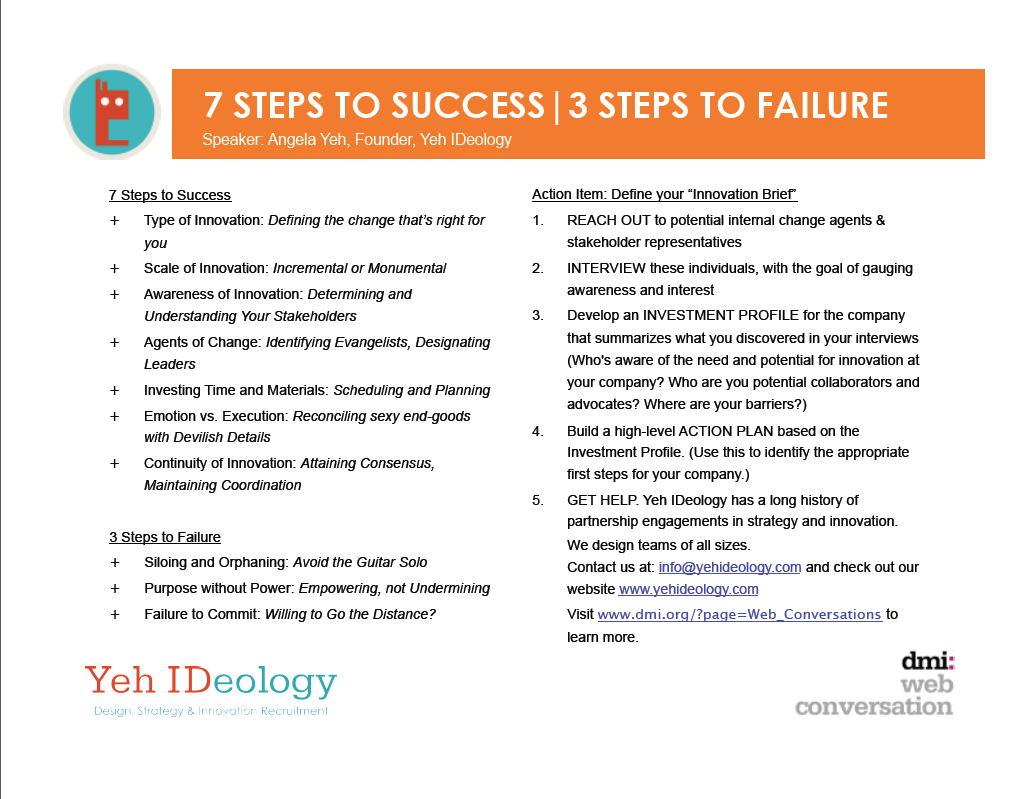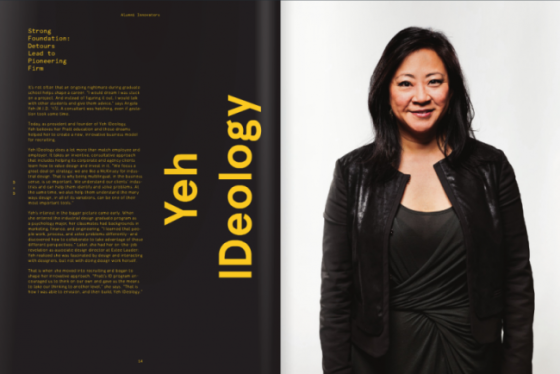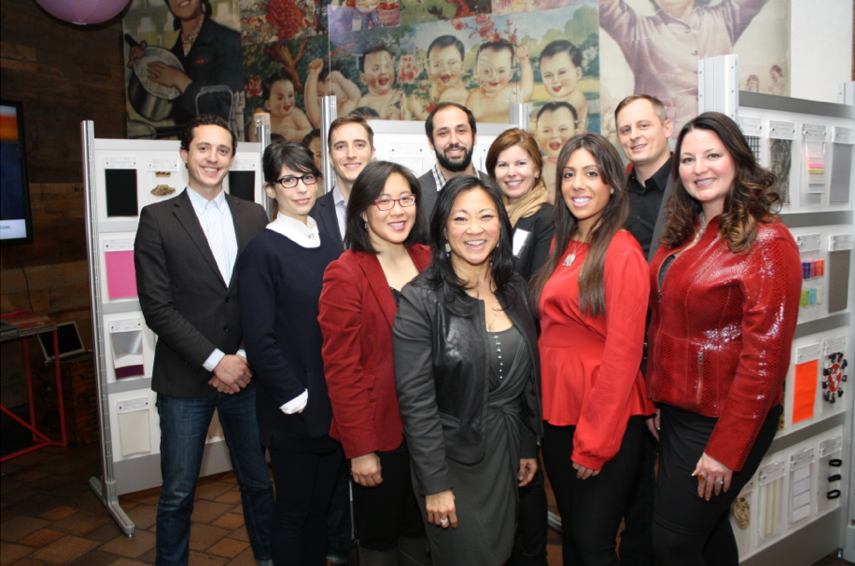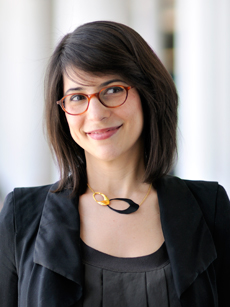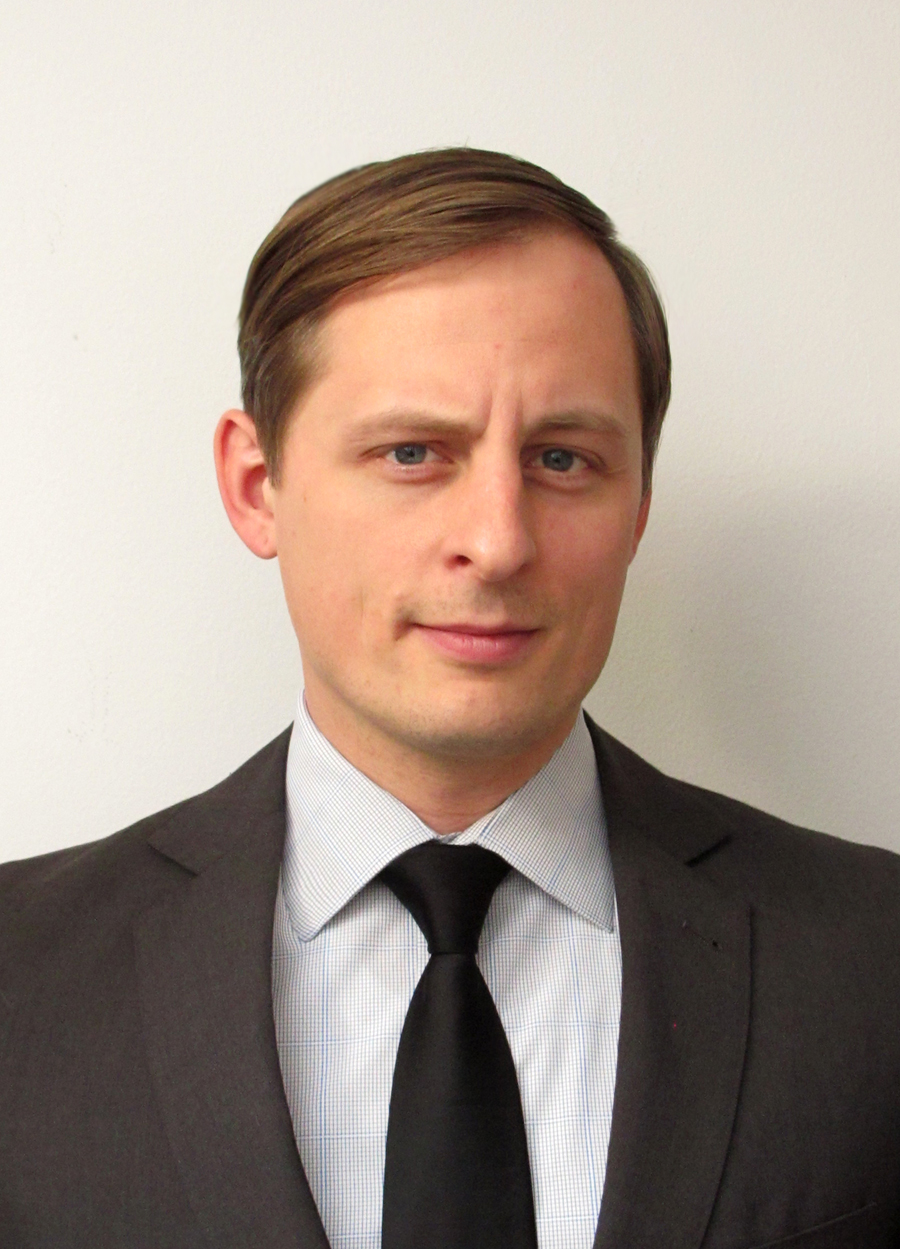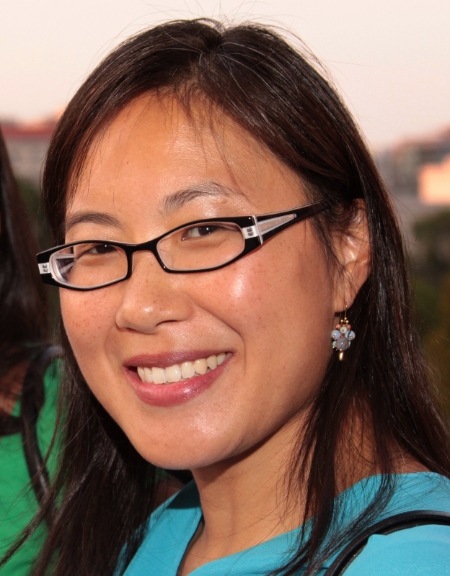Checkout #MondernMonday on Twitter at 1:00pm as Angela Yeh joins other designers and educators to discuss their thoughts on Mentoring the Next Generation of Design. http://www.idsa.org/news/member-news/mentoring-next-generation-design
Integrating Innovation: A One-Page Cheat Sheet
Last November, Angela Yeh, Founder and CEO of Yeh IDeology, took part in DMI’s Web Conversations, geared towards organizations and business owners, management and hiring managers with the specific topic challenge: "How to Build Innovation into Your Organization” In this series, we revisited Angela’s talk, “Integrating Innovation,” while highlighting excerpts, thoughts from the talk, and delving further as we go into each of Angela’s 7 best tips for innovation success and 3 major pitfalls to avoid.
In this final blog entry, we're posting our one-page cheat-sheet which recaps Angela’s 7 Steps to Success | 3 Steps to Failure and hopefully serves as a handy reference with helpful action items to get started.
Interested in this topic or others we've been speaking about? Click on the word bubble to leave us a comment, send a tweet, or connect via LinkedIn! Want to hear directly from Angela Yeh and her 15+ years of design recruiting experience? Drop us a line at info@yehideology.com
Integrating Innovation: Step 3 to Failure
Last November, Angela Yeh, Founder and CEO of Yeh IDeology, took part in DMI’s Web Conversations, geared towards organizations and business owners, management and hiring managers with the specific topic challenge: "How to Build Innovation into Your Organization” In this series, we’ll be revisiting Angela’s talk, “Integrating Innovation,” while highlighting excerpts, thoughts from the talk, and delving further as we go into each of Angela’s 7 best tips for innovation success and 3 major pitfalls to avoid.
Shall we continue?
INTEGRATING INNOVATION Step #3 to Failure: Failure to Commit. Are You Willing to Go the Distance?

At some point in the innovation process, you’re going to fail. The question is: What do you do after? Do you lay there and give up? Or do you do what you were hired to do and limp, leap, or whatever else it takes to get back up again and forge onward?
If you’re still reading this, then you already know that reaffirming your commitment (and that of your of your team) will be a constant battle in any innovative push. Your next task: learn from your mistakes. Why did you fail? Was it your own darn fault?
If you find yourself suggesting “Perhaps they didn’t see the value in it,” maybe YOU didn’t communicate that value effectively; Maybe you didn’t properly translate the work of one department to another, resulting in a breakdown in coordination and commitment, and, perish the thought, a dreaded silo.
Think back to Step 7, Innovation Continuity. As your initiative moves forward, a major responsibility is actually upkeep – continuing to maintain and nurture the delicate back and forth channels of communication, cooperation, consensus and collaboration. Yes the line-level, nitty gritty duties are what actually make the innovations, but a high-level perspective keeps the overall goals in mind and, ultimately, will help you see the initiative all the way to completion.
This also means your lead change agents are diligently watching your supply of resources, regularly gauging motivation, and constantly thinking, as you progress, how to incentivize the team to continue. Looking ahead, they’re spotting potential barriers and navigating away from potential road-blocks so the rest of the team can focus on the actual vehicles for innovation.
Our best advice here? Learn from your mistakes and keep moving forward. Better yet, read case studies, get advice, speak to colleagues and mentors, and learn from their mistakes (think cost- and time waste avoidance). Remember, innovation requires constant re-evaluation, renewal of buy-in, and team reinvigoration. Everyone must be committed; Everyone must be willing to go the distance.
Good luck. Call us, and let us know how it goes!
Next blog, we’ll recap Angela’s 7 Steps to Success | 3 Steps to Failure with a one-page “cheat-sheet” to refer back to along with helpful action items to get started.
Interested in this topic or others we've been speaking about? Click on the word bubble to leave us a comment, send a tweet, or connect via LinkedIn! Want to hear directly from Angela Yeh and her 15+ years of design recruiting experience? Drop us a line at info@yehideology.com
Integrating Innovation: Step 2 to Failure
Last November, Angela Yeh, Founder and CEO of Yeh IDeology, took part in DMI’s Web Conversations, geared towards organizations and business owners, management and hiring managers with the specific topic challenge: "How to Build Innovation into Your Organization” In this series, we’ll be revisiting Angela’s talk, “Integrating Innovation,” while highlighting excerpts, thoughts from the talk, and delving further as we go into each of Angela’s 7 best tips for innovation success and 3 major pitfalls to avoid.
Shall we continue?
INTEGRATING INNOVATION Step #2 to Failure: Purpose without Power. Empowering, not Undermining
Tell us if you’ve heard or thought this before: “We want to build an innovation center.” We see this mistake frequently—from the organization side as well as the talent spectrum. Yes, it’s great if a company can house its creative minds together to cross-pollinate concepts and solutions, and share in challenges. It’s an attractive label with compelling associations, however, as noted in Step 1 to Failure, they must also work closely and cross-departmentally with management, marketing, design, finance, customer service, whatever your departments might be—or you may be setting your team up for failure right from the get go.
This aspect of innovation hinges on access. You must empower your agents to cut through red tape and bureaucracy and enact the change you’ve all agreed upon. This echoes back to Step 5 and how much time & materials a company is willing to invest in innovation. If your agents do not have the sufficient time, or team members, or financial support, they risk being all purpose, but no power.
To avoid this requires buy-in and pre-planning, plus a solid commitment from management. Start this conversation early and avoid undermining your own efforts. Just as effective laws require a method of enforcement, make sure your initiative can deliver on the grand ideas—make sure it has legs to bridge gaps and teeth to make decisions and take action.
Next on our blog series: Step #3 to Failure: Failure to Commit. Are You Willing to Go the Distance?
Interested in this topic or others we've been speaking about? Click on the word bubble to leave us a comment, send a tweet, or connect via LinkedIn! Want to hear directly from Angela Yeh and her 15+ years of design recruiting experience? Drop us a line at info@yehideology.com
Integrating Innovation: Step 1 to Failure
Last November, Angela Yeh, Founder and CEO of Yeh IDeology, took part in DMI’s Web Conversations, geared towards organizations and business owners, management and hiring managers with the specific topic challenge: "How to Build Innovation into Your Organization” In this series, we’ll be revisiting Angela’s talk, “Integrating Innovation,” while highlighting excerpts, thoughts from the talk, and delving further as we go into each of Angela’s 7 best tips for innovation success and 3 major pitfalls to avoid.
Shall we continue?
INTEGRATING INNOVATION Step #1 to Failure: Siloing & Orphaning. Avoiding the Guitar Solo

Steps 1-7 covered our best tips for innovation success. By now, you’ve decided the type(s) of innovation at the proper scale, determined your starting point, elected your leaders, laid out a plan, trimmed down distractions, and wrangled everyone to the same page. If you’ve made it this far, you’re ready to discuss failure.
Step 7, in particular, focused on the need for consensus and coordination, whether across a team, a department or company-wide. As you move forward, this will be your biggest challenge: Keeping your initiative alive and current on everyone’s planner, while juggling the rest of your other hats. This is a time when eyes begin darting down at smartphones and chairs are being slowly wheeled back to their desks.
This is because you’re proposing systematic change. And change is hard. Very rarely do we have the luxury of building from scratch and the longer a process or set of protocols has been in place, the harder it will be to adjust course. Imagine attempting to turn a kayak versus cruise ship.
To turn the ship and roll with this natural tendency towards business-as-usual, you will need to identify your barriers and devise plans to break them down or circumvent altogether. This goes back to your plan of action in Step 5, the details you’ve sussed out in Step 6, and of course, consensus and coordination in Step 7. Or rather, the flip side of these steps—where if you fail to plan correctly, you risk your efforts becoming siloed or worse, orphaned and abandoned altogether by the very teams you just met with. As fun as it looks in live concert, don’t let this be your guitar solo.
And yet, sometimes it’s unavoidable for any variety of reasons: a lack of capability, interest or appropriate vision, insufficient time—there never is—minimal resources, excessive red tape, or bloated bureaucracy. Sound familiar? Take heart because you’re not alone. As an example of silo-ing, we had one corporation where the company owned many different businesses. Because of their vast infrastructure, they missed multiple opportunities to share resources, which greatly impacted their bottom line from a cost standpoint, as well as their ability to coordinate initiatives across these businesses. Understanding this, we brought in someone who knew systems; someone comfortable reaching across different departments and disciplines that could balance all the individual objectives, while also identifying opportunities for increased connectedness and efficiencies. In this case, this particular change agent was inserted at a very high level to work with everyone in the entire chain, from the C-suite to IT to marketing, design, customer service, and even shipping. Their key role: educating stakeholders to be as knowledgeable as they are and attaining consensus on the need to innovate internally—before addressing other sexier end-goals specific to each individual business unit.
At Yeh IDeology, we think of this ability to educate as being multilingual: an ability to speak to all stakeholders in their own language, then translate and communicate the needs, objectives, and capabilities they discover to all other stakeholders involved; a capacity and willingness to hear out all the challenges and incorporate appropriately into current efforts or future initiatives; and an authentic understanding that a success for the innovation team is ultimately a success for all within the organization.
Key takeaways: Get to know your various teams and departments and the potential barriers you’ll face. Then, identify effective channels of communication and focus on keeping those open and updated. Involve all your stakeholders and delegate this priority to them as well. As noted in previous steps, enlist as many stakeholders as possible and keep them involved with relevant roles and responsibilities. Active participation breeds broad ownership, and in turn, better advocates for communicating the change that is needed. Build this ownership and messaging in company-wide; that way, the efforts of the various teams—though individual—remain coordinated and integrated within the larger initiative. Then, with a solid mesh network in place—whether it be through, up, over, around or under—focus on moving forward.
Next on our blog series: Step #2 to Failure: Purpose without Power. Empowering, not Undermining
Interested in this topic or others we've been speaking about? Click on the word bubble to leave us a comment, send a tweet, or connect via LinkedIn! Want to hear directly from Angela Yeh and her 15+ years of design recruiting experience? Drop us a line at info@yehideology.com
Integrating Innovation Step 7
Last November, Angela Yeh, Founder and CEO of Yeh IDeology, took part in DMI’s Web Conversations, geared towards organizations and business owners, management and hiring managers with the specific topic challenge: "How to Build Innovation into Your Organization” In this series, we’ll be revisiting Angela’s talk, “Integrating Innovation,” while highlighting excerpts, thoughts from the talk, and delving further as we go into each of Angela’s 7 best tips for innovation success and 3 major pitfalls to avoid.
Shall we continue?
INTEGRATING INNOVATION Step #7: Innovation Continuity. Obtaining Consensus / Maintaining Coordination

Image
Steps 1-6 covered different types of innovation, scaling your initiative(s), determining your starting point, identifying your change agents, beginning your plan of action, and balancing your exciting end-goals against the tough details that demand your focus.
In the case study from Step 6, the team came to us to build an innovation team so to be perceived as “a Google or Apple.” The tough details, however, were internal regarding their management structure, which had to be addressed first before considering the nuances of their external persona.
This segued beautifully into a listener comment that came in during the original webinar: “What if, during an innovation initiative, despite creating innovative solutions and implementing them, the C-Suite still doesn’t change their management process?”
This is a common scenario. You’ve probably seen it before where “innovation” is being mandated from the top-down, while solutions are germinating from the middle- and bottom-up. There’s nothing wrong with this structure, except when the C-Suite – despite believing in the value of innovation, and understanding your solutions conceptually – underestimates or misinterprets their value, and as a result, changes their investment in the project, and/or fails to adapt their processes to the very change they mandated.
Sometimes its a matter of time and timing. It may take an organization multiple generations of exposure for an innovative idea to take hold. There may be different C-level individuals at the helm, or numerous teams bringing different solutions to the table that compete for company dollars and attention. In some cases, the innovation team itself evolves, is laid off or moves on, and a new set comes in to redevelop the solutions. Sometimes a project just needs several pitches to convince the C-suite it’s a good idea worth investing in.
The key here is continually educating your stakeholders, particularly those holding the purse strings or the power necessary to move forward. It’s about teaching the various constituents, obtaining buy in, and, once you get going, maintaining that consensus and coordination. At Yeh IDeology, we frame it with this question: How do you get everyone on the same page and also keep them turning at the appropriate pace?
In examples we’ve seen, you could have a variety of individuals from different departments coming to the table, all touting that they need innovation and they're ready to support it. Then, when it comes down to building the program, and they’re knee deep in a new product concept or initiative, they suddenly realize “Wow, everyone has a completely different perspective on what’s really needed and how much they’re willing to invest.” It’s about understanding – each team member knowing the other and the entire team, as a whole, while sharing the same vision, plan, and understanding of the objectives.
In some companies, this understanding must extend across an entire organization, requiring the right leaders to effect that change on a corporate-wide structure. In others, it’s very specific to a more narrow aspect of the business, whether that be technology, sales, or customer service, a certain product category, etc.
It’s worth re-mentioning here that innovation is an iterative process and throughout the discovery and execution stage new findings can change the course and direction of an initiative. Be mindful when this happens. It's wise to touch base with all the stakeholders involved so that everyone with a hand in the project is adjusting efforts and expectations accordingly.
So remember, regardless of the variables – we can’t emphasize this enough – continuity of innovation relies on consensus and coordination. Your team must be clear on the deliverables for each department, manager, and stakeholders, while constantly communicating and educating each other every step of the way. Say it with us: consensus and coordination, coordination and consensus.
Next on our blog series: Step #1 to Failure: Siloing & Orphaning. Avoiding the Guitar Solo
Interested in this topic or others we've been speaking about? Click on the word bubble to leave us a comment, send a tweet, or connect via LinkedIn! Want to hear directly from Angela Yeh and her 15+ years of design recruiting experience? Drop us a line at info@yehideology.com
Integrating Innovation Step 6
Last November, Angela Yeh, Founder and CEO of Yeh IDeology, took part in DMI’s Web Conversations, geared towards organizations and business owners, management and hiring managers with the specific topic challenge: "How to Build Innovation into Your Organization” In this series, we’ll be revisiting Angela’s talk, “Integrating Innovation,” while highlighting excerpts, thoughts from the talk, and delving further as we go into each of Angela’s 7 best tips for innovation success and 3 major pitfalls to avoid.
Shall we continue?
INTEGRATING INNOVATION Step #6: Emotion vs. Execution. Reconciling Sexy End-Goals with the Devilish Details

Steps 1-5 covered different types of innovation, scaling your initiative(s), determining your starting point, identifying your change agents, and beginning your plan of action.
Ideally, this has proven fun and informative, and put you actively in touch with many members of your organization. With a comprehensive list of Wants and Needs in hand, you should be ready to push forward.
Today’s post, therefore, is about focus.
At this phase of the project, with so much information in front of you, you’re likely to get sidetracked by the very lofty ambitions you’ve just collected. It hinges on visibility. As an example, one of the most common UX/UI needs that we hear from clients is: "We want someone who can make us look like [pick your favorite fruit-inspired tech giant or popular search-engine company].”This is a great end-goal – to be viewed as a peer to a top performer – but it fails to recognize the operational and infrastructural nuances that often underpin this sort of major innovation. When it comes to design, your internal stakeholders often gravitate towards branding and the aesthetic rather than the technical and functional. They get excited by the blue-sky aspirations and gloss over the drier, necessary steps to build a foundation for your project. The majority of your stakeholders will likely fall in this category, with a comparatively lower awareness of innovation than you – whether its not their background or expertise, or they've been more on the support side rather than leadership. In fact, the majority of seasoned design professionals and leaders also fall into this trap because beauty is so captivating. Even when you are consciously aware of the practical need to build the foundation, we’re still strongly drawn to more visible aspects of a project.
In the case of this example, the initial challenges are actually internal, regarding their management structure. So before they could get to being the next Apple or Google, they need to consider what was under their roof – which had nothing to do with the visible, outward facing aspects of their company. As designers, this comes as little surprise. Sexy end-goals are the most remarkable aspects of your initiative, and often the most exciting. It’s the fancy wrapping that gets buy-in, but the actual implementation, the contents of this package, will demand most of your focus, capability, and resources. The key here: build function side by side with aesthetics.
So how do you stay on track? Maintain a clear distinction between exciting blue-sky aspirations and the key necessities. Then, recognizing the emotional incentives around these aspirations, use this to justify attacking the necessary details. Build this into your objectives with constant reminders to stay focused on the key necessities. Educate your stakeholders on this relationship between sexy end-goals and the devilish details and you give your innovation initiative a fighting chance.
Next on our blog series: Step #7: Innovation Continuity. Obtaining Consensus / Maintaining Coordination.
Interested in this topic or others we've been speaking about? Click on the word bubble to leave us a comment, send a tweet, or connect via LinkedIn! Want to hear directly from Angela Yeh and her 15+ years of design recruiting experience? Drop us a line at info@yehideology.com
Integrating Innovation Step 5
This past November, Angela Yeh, Founder and CEO of Yeh IDeology, took part in DMI’s Web Conversations, geared towards organizations and business owners, management and hiring managers with the specific topic challenge: "How to Build Innovation into Your Organization” In this series, we’ll be revisiting Angela’s talk, “Integrating Innovation,” while highlighting excerpts, thoughts from the talk, and delving further as we go into each of Angela’s 7 best tips for innovation success and 3 major pitfalls to avoid.
Shall we continue?
INTEGRATING INNOVATION Step #5: Investing in Innovation: Time & Materials
The last four blogs focused on identifying types of innovation, scaling your initiative(s), determining your starting point and identifying your change agents.
Whereas Steps 1 through 4 focus on research and familiarization with your organization, Step 5 is about action, or more precisely, your plan of action.
A plan of action takes into consideration all of your findings from Step 1-4 and considers the schedule and amount of resources necessary to bring this initiative to life. In other words: Time and Materials. How much time is needed for the scale of change you desire and are you willing to invest this time? Does it jive with your existing calendar(s)? What about your materials including financial capital, space and equipment, and, of course, human resources?
One thing we’re all familiar with is “yesterday.” We’re in such a constantly shifting economy, with an incredible urgency to innovate on ridiculously tight timelines. To be fair, we’ve seen many successes born of great speed and action. On the flipside, if you don't allow some programs enough time to germinate, to build up sufficient research to formulate a strategy, and then make the time to execute, you’re risking failure right out of the gates.
The key word here is: balance. Balance between failing fast and taking the time to think; between making vast, rapid changes, and slow, incremental tweaks. Each have their merits, but in the context of your plan of action, they also have an appropriate place and time.
As an example, one corporation that we worked with wanted to develop new products on an incredibly short time frame – about 3 to 6 months. In reality, however, it took them closer to a year or two. Another, in the manufacturing space, went the other direction. They said, “Let’s not build something for now; let’s build something for 10 - 15 years down the line.” And off they went, but at some point, they hit a wall. They realized that this too didn’t work; that all this pontification doesn’t lead to anything without clear metrics, true calls to action, and definitive timelines.
So how do you begin determining which plan suits you best? Start by making a list, divided into two sides: Needs (Must Haves) vs. Wants (Nice to Haves). Then take a page out of the designers handbook and make a 2x2 grid. Divide it like your list, left and right, for Needs vs. Wants. Then divide it again, top and bottom: Easy (aka “Low Hanging Fruit”) vs. Difficult (aka longer-term planning and/or investment).
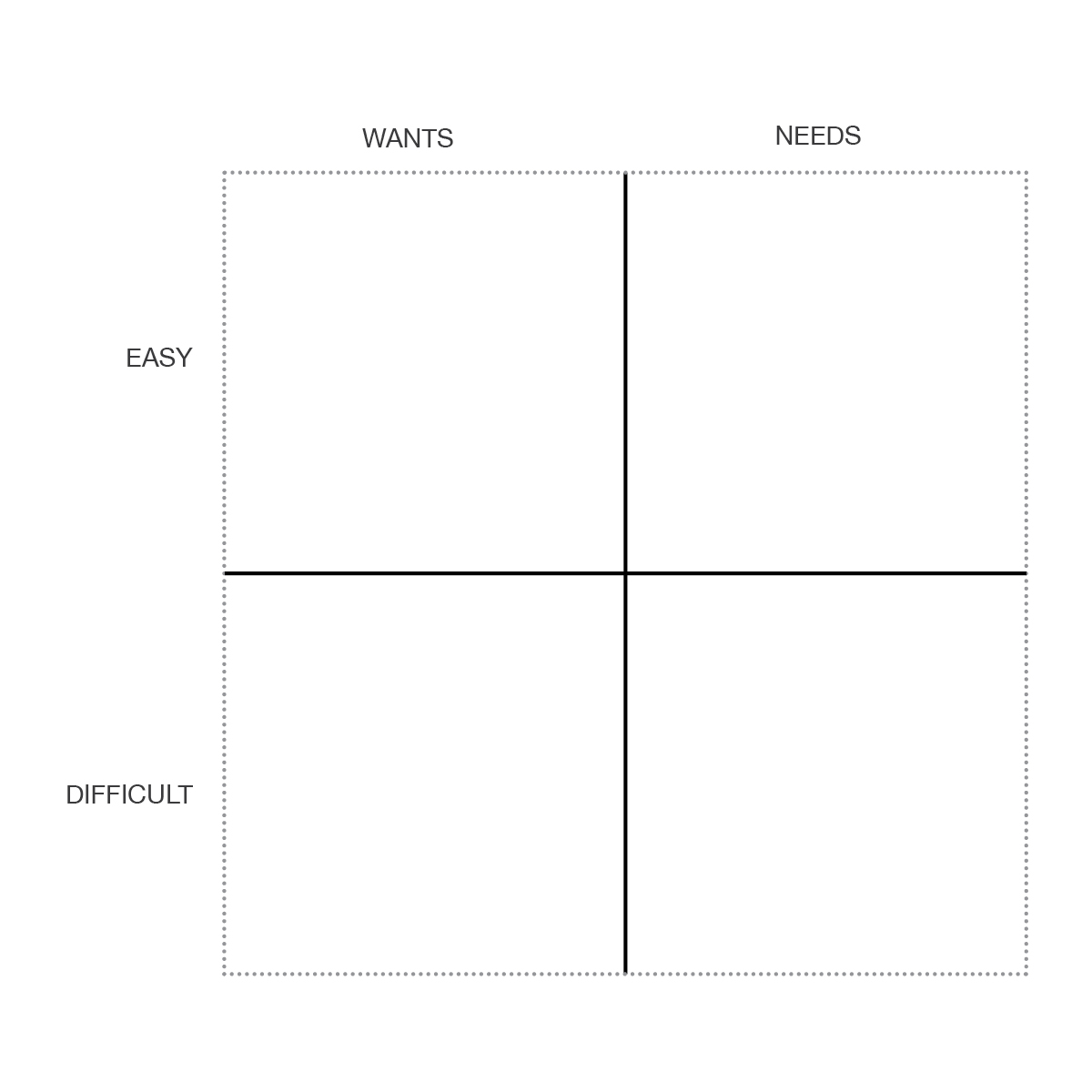 Much of the needs and wants you’ve already begun discovering in Steps 1-4. Continue to draw information, concerns, complaints, and challenges from your stakeholders. Add this to your list and plot it in your grid. Looking at the intersections and determine what to tackle first.
Much of the needs and wants you’ve already begun discovering in Steps 1-4. Continue to draw information, concerns, complaints, and challenges from your stakeholders. Add this to your list and plot it in your grid. Looking at the intersections and determine what to tackle first.
Bottom line: Be realistic. Yes each organization is different, and each industry will have its own timelines and material demands. It’s about understanding the full scope of what needs to be invested in – how long and how much – and planning around that. That’s the balancing act: what’s needed vs. what’s realistic in the time you have with the resources you have. This is a duty for a change agent (which happens to be our specialty!).
Next on our blog series: Step #6: Emotion vs. Execution. Reconciling Sexy End-Goals with the Devilish Details.
Interested in this topic or others we've been speaking about? Click on the word bubble to leave us a comment, send a tweet, or connect via LinkedIn! Want to hear directly from Angela Yeh and her 15+ years of design recruiting experience? Drop us a line at info@yehideology.com
Save the Date! 5th Annual Design Summit
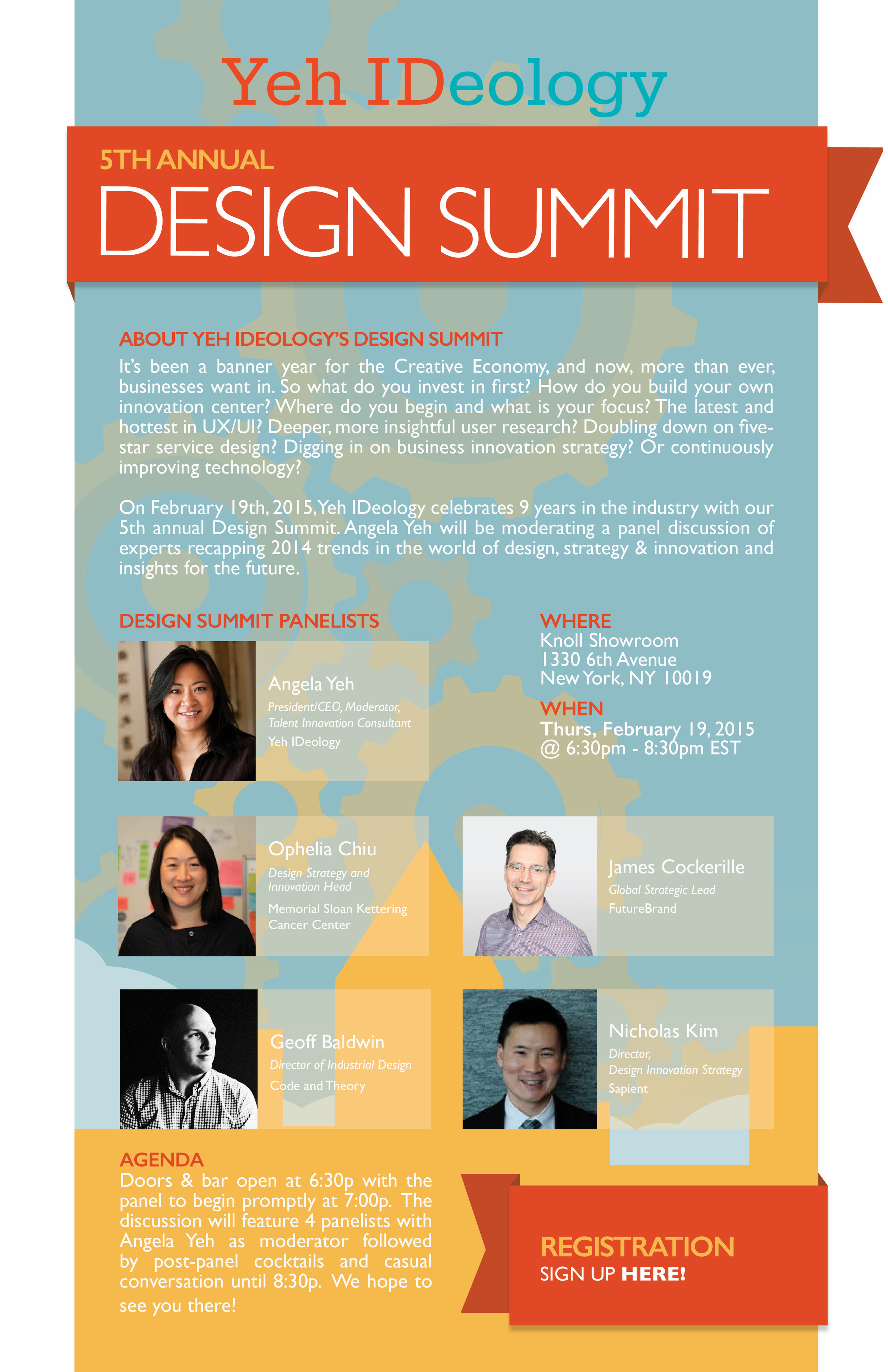
About Yeh IDeology's Design Summit
It’s been a banner year for the Creative Economy, and now, more than ever, businesses want in. So what do you invest in first? How do you build your own innovation center? Where do you begin and what is your focus? The latest and hottest in UX/UI? Deeper, more insightful user research? Doubling down on five-star service design? Digging in on business innovation strategy? Or continuously improving technology?
This February 2015, Yeh IDeology celebrates 9 years in the industry with our 5th annual Design Summit.
Join us at Knoll Inc. Showroom for an informal, wide-ranging panel discussion with industry luminaries, as Angela Yeh recaps 2014 to share what we’ve learned and present our latest insights into what’s trending in the business of design, strategy, and innovation.
Registration Sign up here or paste this link into your web browser: https://eventbrite.com/event/8251262749/
Changes in CMF
To quote a design consultant responsible for the look and feel of the Microsoft Xbox 360, “CMF is a specialized area of design that focuses on color, material and finish development. This involves trend research, materials and processes R&D, analysis, strategy and lots of creative thinking… A CMF designer to me is someone who cares about the details of a product and how those details can change perceptions or feelings towards the product.” – R.A.M.
Until recently, CMF has been pigeon-holed as a secondary phase in the design refinement process. With the need for brand differentiation becoming ever more critical, however, CMF is currently experiencing substantial growth not only as a critical aspect of the development process, but in some sectors, a distinct career role unto itself; To the extent that, at any given time, we’re running at least one, if not more searches for professional candidates whose primary focus is on color, material, and finish.
Correlated with this trend is an increasing level of sophistication for CMF on the part of brands and designers. Whereas in the past, one specification may have served across the board, brands will often now spec combinations unique to each their retail outlets. This is particular evident if you track brands and their product line exclusives for big box retailers – Best Buy, Target, Wal-Mart and CostCo to name a few. Footwear brands have been doing this for years; developing different CMF collections for each of their retailers, from Modell’s and DSW, to Dicks and Foot Locker.
Retailers themselves are getting into the game by developing their own branded private-label products – for example: Cobalt (Lowes), Black & Decker (Sears), or Husky (Home Depot).
CMF matters – for brand and product distinction from retailer to retailer, as well as within the category for low-end to high-end differentiation. To this end, developing, sourcing, tracking, and analyzing the effects and success of a CMF library, and maintaining all this, is quite the feat. Not to mention juggling the existing demands of brand language continuity, growth targets, and new market penetration.
Furthermore, the specialty itself is constantly changing – often beyond the scope of even the savviest of industrial design generalists. Case in point, whereas past materials were sourced off-the-shelf, many current developers conceive and design their own materials to keep pace with novel, ever-evolving technological demands such as electrical conductivity, state-changing capabilities, sensitivity to biological outputs including heat, sweat, and salinity, and even on-the-fly camouflage. Such designers occupy a niche off-shoot of the CMF umbrella, dubbed CMD for Color, Material Design.
Simply put, the days of CMF as an added bonus and discrete “step” are long gone and the nuanced CMF skill set that the market is now demanding, demands a design specialist.
So what’s the catch? At first glance, this pipeline of specialists appears somewhat in short supply; that is because, until recently, many designers counted CMF as just one of their many tools; rarely a professional focus on its own.
So what does that mean for designers and design employers? It means a whole new sector is emerging, with myriad opportunities to shape it, guide it and capitalize on… and you might just want to be part of it.
Integrating Innovation Step 3
This past November, Angela Yeh, Founder and CEO of Yeh IDeology, took part in DMI’s Web Conversations, geared towards organizations and business owners, management and hiring managers with the specific topic challenge: "How to Build Innovation into Your Organization” In this series, we’ll be revisiting Angela’s talk, “Integrating Innovation,” while highlighting excerpts, thoughts from the talk, and delving further as we go into each of Angela’s 7 best tips for innovation success and 3 major pitfalls to avoid.
Shall we continue?
INTEGRATING INNOVATION Step #3: Awareness of Innovation. Establishing the Baseline Amongst Your Stakeholders.
The last two blogs focused on identifying the types of innovation best-suited to your organization and the challenges at hand, and the appropriate scale of this initiative. The “What” and “Where” and “How much” of integrating innovation.
At this stage, it can be very tempting to just go and get started – avoid this temptation. Before you go doling out tasks, it’s important to identify your stakeholders – who they are and where they stand in respect to innovative change. This will likely identify potential challenges and/or quick wins. Begin by asking: Who is aware of innovation or disruption occurring in your space and other related industries? It doesn’t matter what role you play or where you sit within the hierarchy, you need to assess those around you. It’s about education – understanding those above you, below you, at your level and across all departments – who they are, what they do.
Of this group, to what degree are they aware of innovation? How much do they already know? Are your stakeholders starting from scratch, somewhere in the middle, or ahead of the pack? Take copious notes – this is where you’ll begin to see gaps, key advantages and critical relationships to leverage down the line, as well as discover potential challenges and/or quick wins that all feed into your overall strategy. Keep digging. Given the initiative, how much more education will your stakeholders need in order to contribute? For that matter, ask yourself whether you’re part of this group, and how much education will you need to participate.
Remember this: Your capacity to understand innovation affects your potential to achieve it. The point here is to pause and take stock. Determining who and what you have to work with helps establish your starting point, your baseline, and your strategy going forward.
Next on our blog series: Step #4: Agents of Change. Identifying Evangelists, Designating Leaders.
Interested in this topic or others we've been speaking about? Want to hear directly from Angela Yeh and her 15+ years of design recruiting experience? Drop us a line at info@yehideology.com
Integrating Innovation Step 2
This past November, Angela Yeh, Founder and CEO of Yeh IDeology, took part in DMI’s Web Conversations, geared towards organizations and business owners, management and hiring managers with the specific topic challenge: "How to Build Innovation into Your Organization” In this series, we’ll be revisiting Angela’s talk, “Integrating Innovation,” while highlighting excerpts, thoughts from the talk, and delving further as we go into each of Angela’s 7 best tips for innovation success and 3 major pitfalls to avoid.
Shall we continue?
INTEGRATING INNOVATION Step #2: Scaling Innovation. Incremental or Monumental.
Last week’s blog focused on identifying the types of innovation best suited to your organization and the challenges at hand. Call it the “What” and “Where.” Which brings us to “How much?”
So you’ve identified the change you want – but what amount do you need? To what extent are you even capable of now in the near-term, and going forward with the right resources and investment? We’ll discuss the latter in Step 5, but for now, let’s focus on another essential part of the Discovery phase: Scale.
Clients often come to us and say: “It’s time for us to build an innovation center.” We hear this a lot. But for what purpose? Let me say that in every organization, there are multiple initiatives that have to be invested in. Some of them will be incremental, and some will be monumental and some will be low hanging fruit, and some will require a great deal of investment, and a lot more collaborators brought in to really make that initiative successful. It’s important to look at your organization first. If you can afford to build an “innovation center” outright, then so be it; that’s incredible. But in reality, the majority of businesses out there do not understand the amount of investment that this actually takes, and rarely are they set up to effectively execute this kind of monumental shift.
Pamela Decesare, DMI board member sums up the inherent challenges nicely: for most businesses, there’s “distribution channels, there’s methods, processes, and things they have in place to run the business as it is… How do they figure out how big a shift they need to make? How do they know what [kind of shift] they’re even willing to make?” More often than not, the changes you’re able to make initially towards innovation will be incremental.
So where do you begin? How do you assess and decide amongst the various priorities that exist if you cannot afford to build an entire innovation center? In most businesses, there is an existing structure in place, which can be complex to look at (and difficult to change), but there is a solution to this. It’s about being more analytical about your process and system, before you go ahead. I heard this term applied recently to this phase of a project – taking a diagnostic. A lean team has to look at the big picture; think of the strategy for their organization and brand / cross-brand; be mindful, and even champion, the challenges and goals of the various divisions (regardless of your team’s home base); and delve into the various sectors of the business, whether structural to the entire firm or specific to particular product categories. You have to list and, kind of, profile each challenge, and then collectively decide which of them to hit first.
This list, analysis, and resulting prioritization is the crux of this phase. Use this initial diagnostic – of both your department and company as a whole – to establish the foundation for determining your scale.
Next on our blog series: Step #3: Awareness of Innovation. Establishing the Baseline Amongst Your Stakeholders.
Interested in this topic or others we've been speaking about? Want to hear directly from Angela Yeh and her 15+ years of design recruiting experience? Drop us a line at info@yehideology.com
Yeh of a Day

 Process Mapping Yeh IDeology’s Strategy & Methodology while borrowing ideas from “The Service Startup: Design gets Lean” by Tenny Pinheiro. Of course, we can’t do this without Nico.
Process Mapping Yeh IDeology’s Strategy & Methodology while borrowing ideas from “The Service Startup: Design gets Lean” by Tenny Pinheiro. Of course, we can’t do this without Nico.
For 364 days a year, we devote our time and energy to our clients, our candidates and the science of matching talent with culture. One day a year is purely devoted to Yeh IDeology’s “Day at the Beach”.
At Yeh IDeology, our philosophy is to design healthy, sustainable relationships and build mutually prolific partnerships and teams. Since much of our focus is forging alliances for others, we sometimes forget to return ourselves the favour and bypass our own internal development.
As summer is in full swing, so is Yeh IDeology. We are in an exciting state of growth and ready to ramp up to the next step. To celebrate this, our President & CEO, Angela Yeh, invited all of us to a “Yeh of a day” on the beach.
A beach day might not sound as productive as it does, but experience tells us the fundamental building blocks of an innovative organisation are first and foremost the people that make up the organisation and company culture.

 Learning from Marty Neumeier’s “ZAG” and learning how to surf - what’s a better compliment than the two?
Learning from Marty Neumeier’s “ZAG” and learning how to surf - what’s a better compliment than the two?
So, what exactly does the Yeh IDeology do on the shore of Long Beach? The first 6 hours is dedicated to brainstorming and process mapping -- this includes dragging our flip-charts to the local mexican restaurant to work through lunch, whilst providing the other diners a complementary design strategy workshop.
After a few tacos and some intrigued faces, it’s time for some fun in the sun! But even our fun time is productive, as Angela gets back into mentoring mode and shares with us her surf skills. There were balancing acts and big splashes, sand castles and Sangria, followed by giant bubbles that brought neighbors out onto the street for an amazing time.
 Can’t have beach day without gigantic bubbles… Want the secret sauce? Wait till you hear it from Angela…
Can’t have beach day without gigantic bubbles… Want the secret sauce? Wait till you hear it from Angela…
It was an educational, collaborative, and all around enjoyable experience where work and play came together. This is why we believe that an environment based on trust and shared values can unite people, where we can collectively bridge ideas and build a foundation that welcomes innovation with integrity and the aptitude to accept, learn and rise from failures, together.
Until our next trip on the LIRR, it’s back to focusing on our clients, candidates and culture, refreshed with lessons learned from a Yeh Beach Day.
"Into Design" at the 2014 Core77 Conference
What does it mean to be taken “into design,” its process and challenges? The first annual Core77 Conference, held on June 19, investigated this question, and more, under the topic for 2014: Object Culture, and Yeh IDeology was there to witness an unfolding of ideas. It also played host to the Core77 2014 Design Awards where the winners of the Consumer Products and Interiors & Exhibitions categories were announced. The day featured an impressive gathering of speakers who discussed the processes behind their work, being a designer in the present day as well as the value of the modern object.
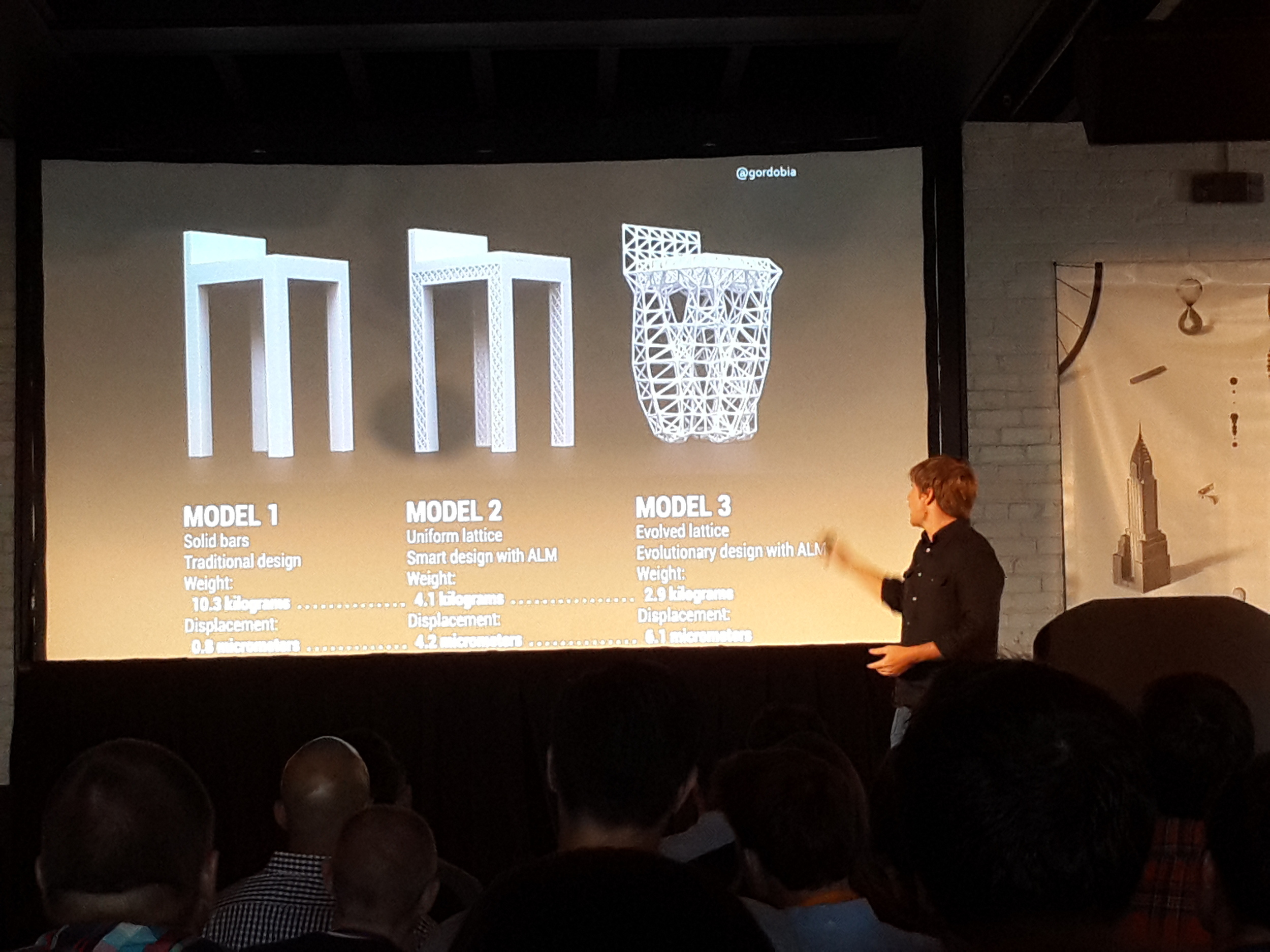
Jordan Brandt - Technology Futurist, Autodesk, San Francisco, CA.
Technology Futurist, Jordan Brandt, in his talk on “How do we teach our machines to Design?”, said that “the world is just asking for design.” There are a multitude of situations in our everyday lives that require designed solutions so how then do designers practice within the field to achieve this?
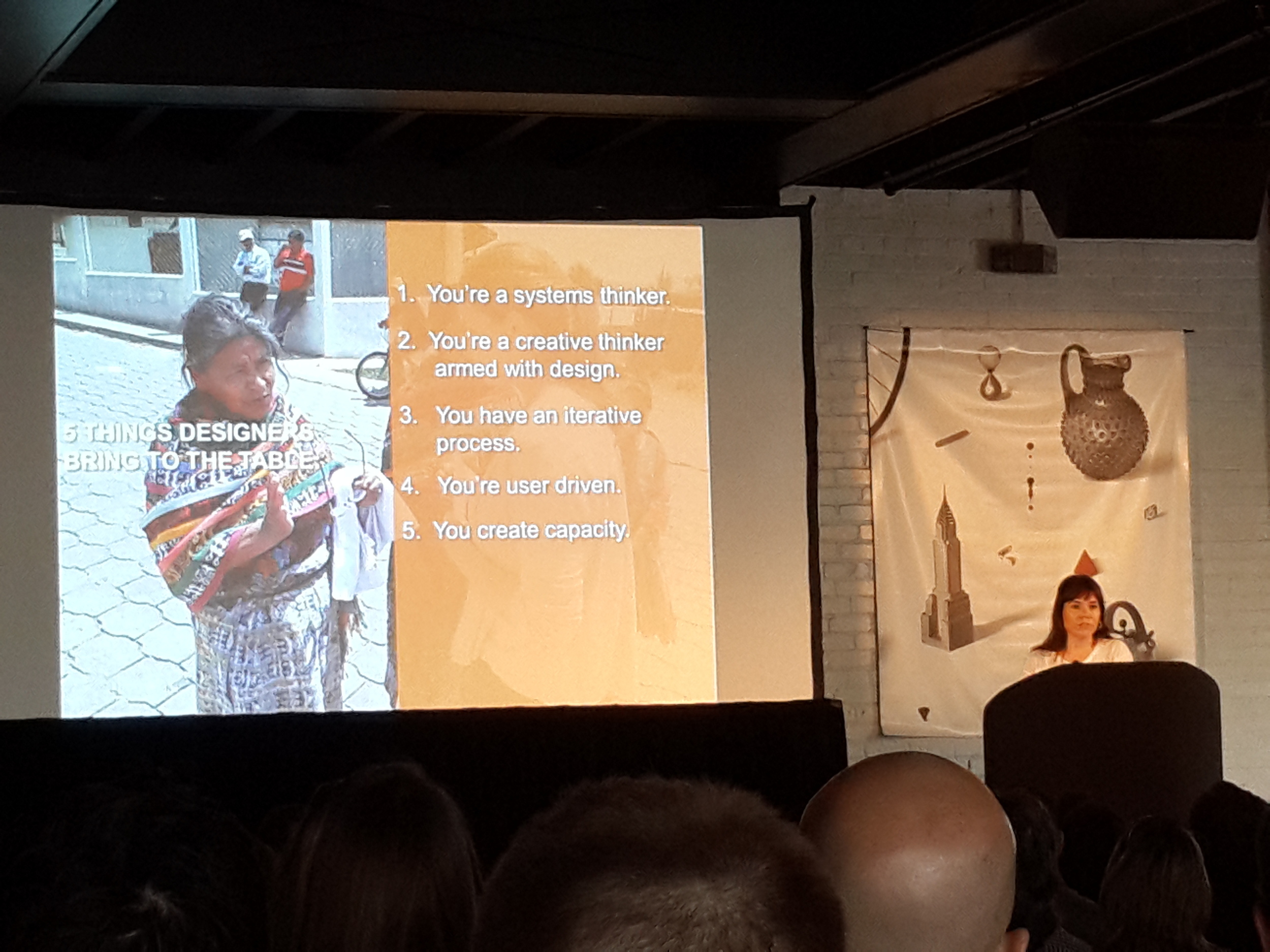
Heather Flemming - CEO, Catapult Design, New York, NY.
For some practitioners, like Heather Flemming, CEO of Catapult Design, it comes down to designers participating and sharing their skills within global development. Her belief was that “It's a rich formidable time for designers to engage in social challenges.”
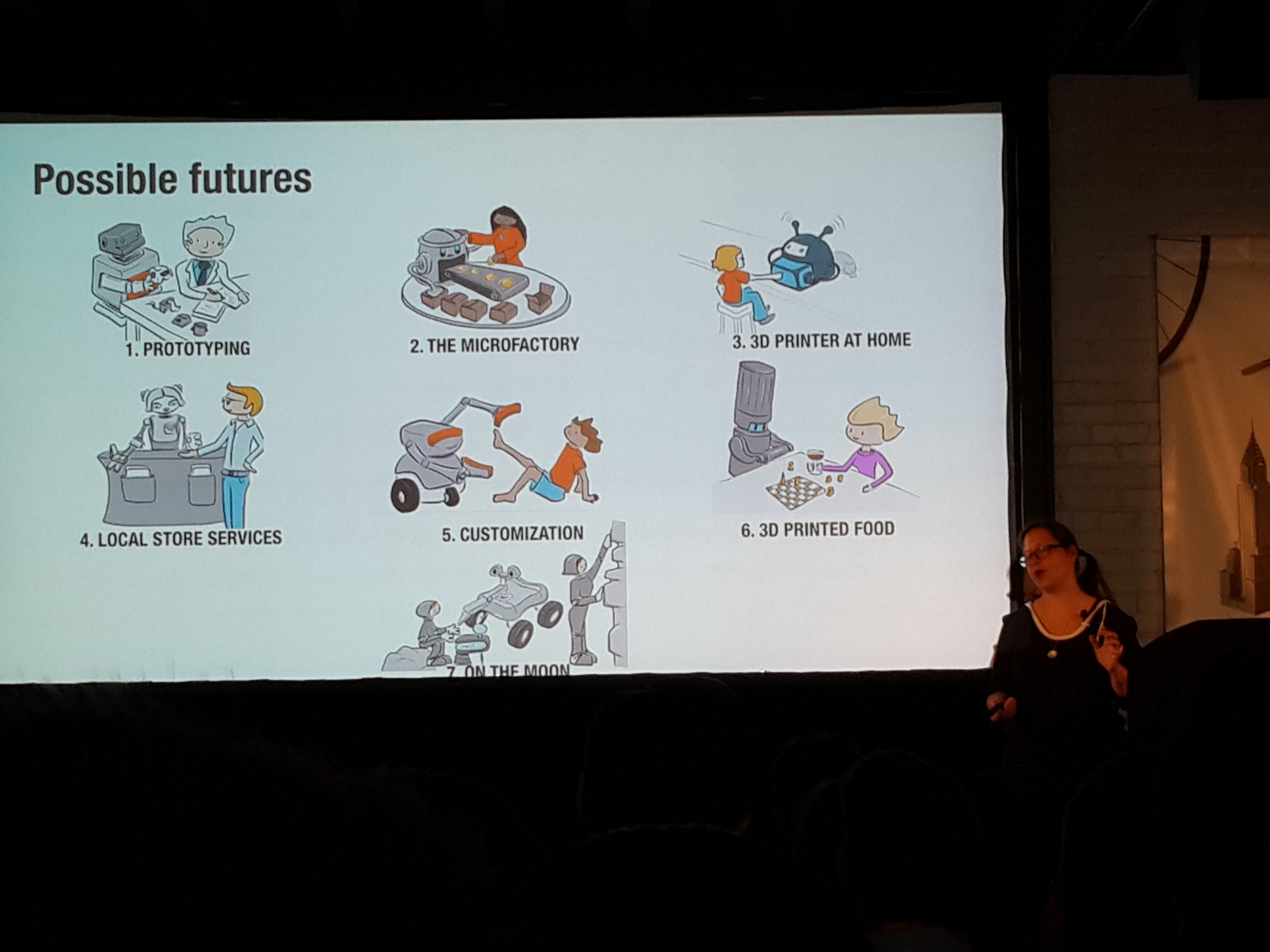
Carla Diana - Designer, Writer, Educator, New York, NY.
And what about the designed object? What meaning does it hold and how do we improve on it? Carla Diana, explored this in her presentation “Bringing Meaning to Objects Through Storytelling” where she used narrative to express the capabilities of 3D printing to our younger generation of future designers. “We should be taking what exists in the world and applying emotions to relate with it… stories are reality + emotion.”
By the end of the day, the conference in itself was a narrative of design: piecing together water filtering pools, bike culture and wearable technology to illustrate the vast space that design occupies in our innovation driven world.
Here are more of our highlights:
"It's about giving people access [to bikes]" to raise awareness and change cultural behavior and mindset - Ethan Frier, Cult of Bike.
"If you only aim for perfection and skip the process, you won't go anywhere" - Michael DiTullo, Design in the C-Suite.
"We cannot build new systems on old models" - Marta Salas-Porras, Neomaterialism.
"Designers should think about the unintended consequences of their work, the environmental, and just as important, social impact" - Colin McSwiggen, Design and Work.
Angela Yeh Joins Alumni Innovators in Pratt Institute's Design by Differentiate Issue No.3
Innovation within business and design can no longer exist separately as the two continue to cross-pollinate globally. The majority of people speak of design and innovation like loose pages in a book; this book itself is dense, but informative, and a quick glance doesn't do it justice. You skim the surface, yet miss the juicy core… In Pratt Institute’s third issue of Differentiate by Design, Angela Yeh joins other Pratt alumni to share their insights to today’s ever-dynamic creative economy and discuss how innovation is a key player for tomorrow’s industry.
Angela applied her Pratt education and previous professional experiences to building a new innovative business model for recruiting, that is, Yeh IDeology. At Yeh ID, we design relationships. Our philosophy is creating deep connections with people that will help us make the perfect match with talent and culture. "We focus a great deal on strategy; we’re like a McKinsey for [design, strategy and innovation]. That is why being multilingual, in the business sense, is so important.” Read more in Different by Design.
You in UX Summit Raffle!
Dear friends of Yeh IDeology, We are raffling off a free ticket (worth $495) to our Yeh ID community! Winner receives full access to the global UX Summit with You in UX this May. You in UX is an online, virtual summit with an incredible line up of top UX mentors from around the world. Take a look at their program agenda.
Please click here to access the raffle.
Entries must be submitted by May 1st.
Good luck!
The Future of Design Work | Yeh & SVA
Recently at New York’s School of Visual Arts (SVA), Angela Yeh sat with Allan Chochinov, their chair and co-founder of MFA Products of Design and Angie Wojak, director of career development to discuss The Future of Design Work. In today’s ever-complex world of business and design, professionals need to understand where design opportunities lie, how to navigate the market and realize the hidden talent brewing right beneath their skin. While this seems obvious, what we have discovered is opposite to this sort of thinking...
Read here for The Future of Design Work in SVA's Hire Edition.
* This article is currently only available in print. To read more issues from SVA's bi-annual Visual Arts Journal, visit here.
Angela with You in UX | Global UX Summit
Do you ever wonder what it takes to explore new territory? Do you want to lead the next generation of UX pioneers? If so, join us at You in UX Summit this May to gain invaluable career insight with some of the best UX mentors around the world. Angela of Yeh IDeology will be speaking at You in UX Summit on May 7th at 3pm PST. You in UX is an online, global summit with an extensive three-week lineup that includes speakers from top UX executives, CEOs and presidents from companies like Amazon, Google, Microsoft, Yahoo!, BlackBerry, SlideShare and more. You in UX grants you global access to more than 30 customizable sessions. This is your opportunity to ask questions for world-class UX role models and mentors.
For the program lineup, please view the link here.
Be inspired and cultivate your talent. Join us at You in UX.
IDSA 4th Annual Design Summit Review
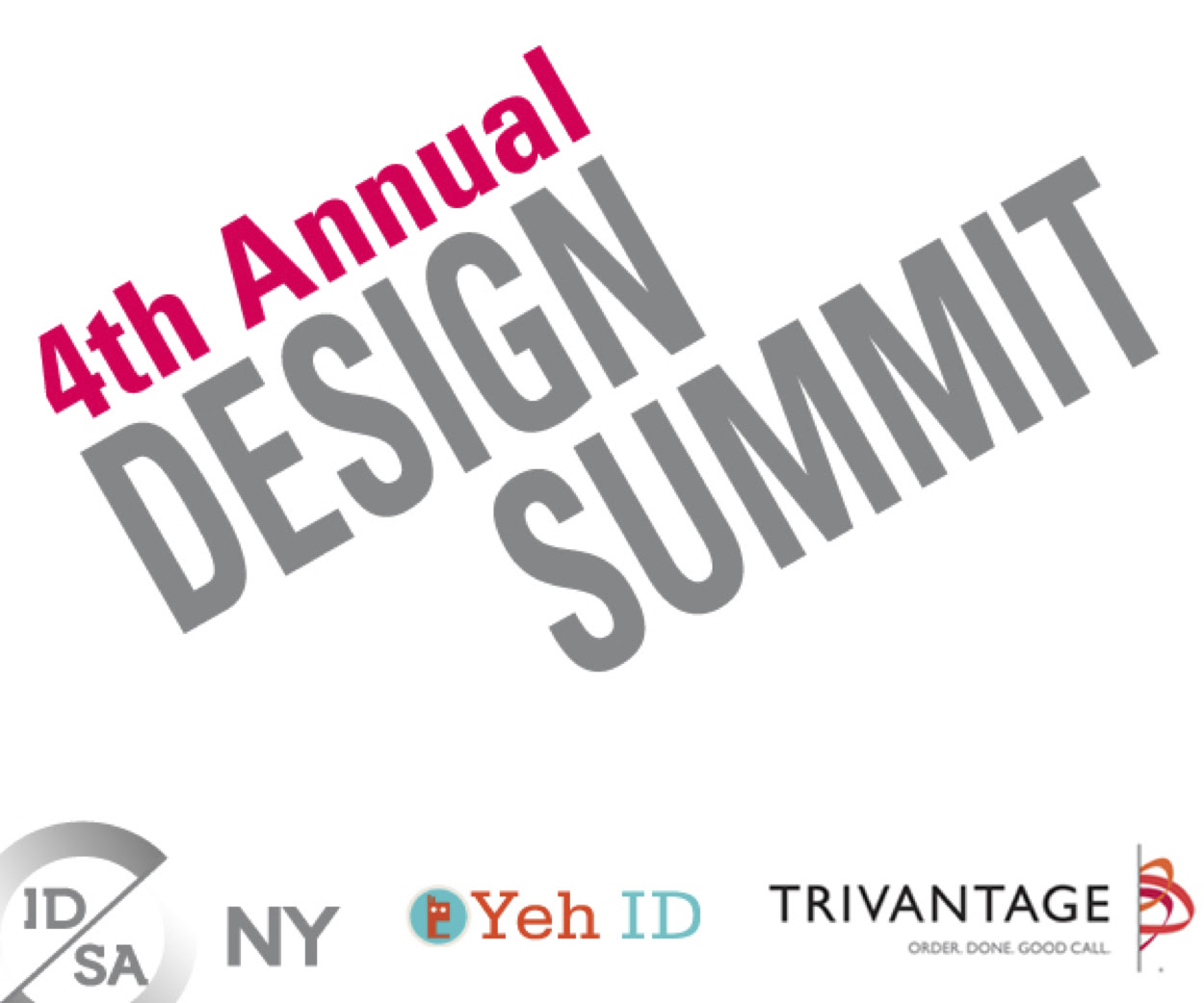 In partnership with IDSA NYC, Yeh IDeology hosted the 4th annual Design Summit on February 27th. This year’s design summit featured a panel of cross-disciplinary design leaders including Erica Eden (Founder of Femme Den and Global Director of Design Innovation of PepsiCo), Rich Thrush (Director of Kaz Incorporated), Mei Mah (Deputy Director of Education at Cooper Hewitt), Dan Grossman (Deputy Design Directory of Martha Stewart Living Omnimedia).
In partnership with IDSA NYC, Yeh IDeology hosted the 4th annual Design Summit on February 27th. This year’s design summit featured a panel of cross-disciplinary design leaders including Erica Eden (Founder of Femme Den and Global Director of Design Innovation of PepsiCo), Rich Thrush (Director of Kaz Incorporated), Mei Mah (Deputy Director of Education at Cooper Hewitt), Dan Grossman (Deputy Design Directory of Martha Stewart Living Omnimedia).
Photo from Paige Mullis at Glen Raven
Our theme of Making It Real was rooted in understanding design as an ever-expanding discipline that is actively shifting both creative and business cultures. We questioned the role of design in today’s complex business landscape? How do different design fields cross-pollinate? How will this shape the future of design? Are these trends here to stay or go?
Dan Grossman shares with us a similar frustration with “all these different levels of design [and having] to label it was always confusing.”
In response, Erica Eden reveals the downfall of design that is this competition between different design disciplines, “I don’t like this competition between Interaction and Industrial Design. Interaction comes from Industrial Design. We all do the same thing [that is] solving a problem.“
The challenge for designers is to know everything and be good at it. Rich Thrush explains that designers must grasp the fundamentals of design (i.e. traditional ID skills) and also “know [their] superpower.”
Eden’s advice, “be shameless” and take risks exploring and discovering. When you know your super power, hold onto it and remember to design to solve the problem.
Share with us your thoughts!
4th Annual Design Summit
IDSA NY presents our fourth annual Design Summit in partnership with Yeh IDeology. This year's theme is ID Fundamentals: Making It Real. We've assembled a panel of cross-disciplinary design leaders to explore the challenges of going from concept to commercialization and what design education does to help (and sometime hinder) that process.
This event was made possible by the generosity of TRIVANTAGE as part of their ongoing Innovation Town Hall series.
Please join us at 6 PM for refreshments and networking. The Panel starts promptly at 7 PM.
Thursday, Feb. 27th | Pod 39, 95 145 E 39th St., New York City | Get tickets
---
Erica Eden | Founder, Femme Den; Director of Innovation, PepsiCo
Erica bridges design and strategy, specializing in uncovering deep desires and delivering on real needs for the elusive and influential female consumer. Erica’s curiosity is about what to make, why it matters and how to connect to the women’s market. Through her work in diverse fields including housewares, health & wellness, automotive, and consumer packaged goods, she sees each design challenge through the eyes of the consumer and pioneers new methodologies that close the gap between design trends and real women. Through her work with Femme Den, she redraws the boundaries of design expertise, expanding the need to understand people to include subtleties of gender and beyond. Erica is now the Director of Design Innovation at PepsiCo's Design Center.
Erica’s work has been featured by The New York Times, World News Tonight on ABC and various design publications including I.D. Magazine, Elle Décor and Blueprint. The Femme Den is recognized as a “Master of Design” in Fast Company’s annual design issue.
---
Rich Thrush | Director, Industrial Design + Innovation, Kaz Incorporated
Rich is a proven industrial design leader adept at utilizing consumer research, analysis, design and innovation skills for the identification, conceptualization and design of consumer product. His diverse history includes working with tech products such as mobile devices (Motorola) to toys (Hasbro). Kaz Inc., manufactures consumer goods under the brands Pur, Braun, Vicks, Honeywell and many others.
He is passionate about problem solving, design thinking and delivering solutions that make an impact on the market and in people's lives resulting in hundreds of patents and design awards. Rich’s focus is on elegantly designed innovative products and experiences with simple stories based on strong consumers insights to delight consumers.
---
Mei Mah | Deputy Director of Education, Cooper Hewitt, National Design Museum
Mei Mah has over twenty years of experience in program design and development, strategic initiatives, and collaborations around design and education. In her current role she is responsible for conveying the mission of Cooper-Hewitt and the importance of design in everyday life through education programs intended to serve a wide range of audiences including teachers, students, professional designers, scholars, and the general public.
In addition to leading the prestigious National Design Awards initiative, she has developed learning experiences for over seventy exhibitions, showcasing the Museum’s extensive collection and exploring contemporary design issues.
---
Dan Grossman | Deputy Design Director, Martha Stewart Living Omnimedia
Dan oversees the design and development of a broad range of products and innovative retail solutions at partners like Macy's, PetSmart and the Home Depot. His responsibilities span product design, project and vendor management, brand development and trend analysis. Prior to this Dan had the opportunity to work for various companies, as well as lead design teams and projects with non-profit design organizations such as Project H Design and Project Breaker. He holds numerous patents and awards and has had his work featured at the Smithsonian Cooper-Hewitt National Design Museum.
Angela Yeh | Founder, Yeh IDeology Panel Moderator
Angela is president & founder of Yeh IDeology LLC, the leading Design & Strategy recruitment firm in the United States. YehID has collaborated with major corporations and top design consultancies across the US and internationally to build creative teams.
Angela has specialized in recruiting for creative talent for over 15 years. She's been an active IDSA member and sat on the IDSA Board of Directors.
Angela taught career strategies at Parsons The New School for Design and has lectured at numerous engagements, including: IDSA National and District Conferences, Design Management Institute Annual Conferences, Lextant Design Forty Webinars, and numerous universities.
Angela holds a BA in psychology from the University of Bridgeport, and honed her keen eye for design at Pratt Institute’s Masters program in Industrial Design.
---

